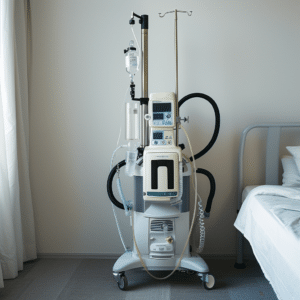Managing Troubled Breathing After Car Accident: Steps for Recovery
Last updated Wednesday, October 30th, 2024

Experiencing trouble breathing after a car accident indicates the need for immediate medical evaluation due to possible serious chest injuries like trauma or punctured lungs. This article directs you to critical actions to take, the potential causes, and the routes to medical treatment – knowledge that could be pivotal in managing your health post-accident. Expect to find actionable advice on initial steps, diagnostic procedures, as well as insights into the recovery process.
Key Takeaways
- Immediate medical evaluation following a car accident is crucial for identifying and treating potentially life-threatening injuries like a punctured or collapsed lung.
- Seeking timely medical treatment for respiratory distress after a car accident is vital and includes undergoing diagnostic tests like CT scans; also, exploring legal options is important for compensation related to medical expenses.
- After treatment for respiratory issues due to a car accident, recovery and rehabilitation are essential, with the understanding that healing timeframes vary based on the severity of the injury and may include physical therapy and consistent follow-up care.
Understanding Respiratory Distress Post-Car Accident
Respiratory distress is a common aftermath of car accidents caused by blunt force trauma to the chest, affecting the lungs and chest cavity. A severe chest injury, such as a punctured lung, can present with varying degrees of severity, influencing both treatment approaches and urgency.
If not addressed promptly, a punctured lung can escalate into a life-threatening situation, such as a collapsed lung. Thus, seeking immediate medical evaluation after a car accident is imperative for promptly identifying potential life-threatening injuries such as a punctured or collapsed lung.
Identifying Signs of Breathing Complications
Recognizing symptoms of breathing complications is the first step towards managing respiratory distress. Symptoms such as rapid breathing, sharp pain during deep breaths, and shortness of breath could indicate severe chest injury or lung damage following a car accident. Bruised or broken ribs could cause sharp pain when breathing, coughing, and may result in abdominal pain, signaling potential rib damage.
A chest wall injury may present with symptoms such as soreness beneath the ribs, pain when breathing, coughing, or laughing, as well as bruising and swelling. Even muscle strain can contribute to chest pain and soreness, especially when moving or taking deep breaths, complicating the act of breathing.
Common Causes Behind Breathlessness
Several factors contribute to breathlessness following a car accident. Direct impacts can cause various injuries such as bruising, muscle strain, and particularly fractured ribs due to blunt force trauma. Safety devices such as seat belts and airbags, although crucial for protection, can lead to chest contusions and other related injuries.
A punctured lung is another significant injury caused by trauma, impairing the ability to breathe and disrupting the oxygen levels in the bloodstream. Not to mention, internal injuries involving the heart and lungs can lead to potential contusions and the risk of internal bleeding, contributing to respiratory distress.
Immediate Actions to Take for Breathing Issues After an Auto Accident
Following an auto accident, swift action is of utmost importance. Experiencing severe chest pain or difficulty breathing warrants immediate medical attention to secure timely treatment for any severe injuries. Chest pain should never be ignored as it may indicate underlying injuries like broken ribs, punctured lungs, or internal bleeding that require immediate care. Prompt diagnostic imaging such as CT scans can accurately diagnose the cause of chest pain and determine the necessary course of treatment.
Once you seek medical treatment immediately, it’s equally important to explore legal options for compensation to offset medical expenses.
When to Call Emergency Services
In the aftermath of a car accident, certain conditions require the immediate attention of emergency services. Should someone endure severe pain or have difficulty breathing, immediate dialing of 911 is necessary. Remember, emergencies are not always visually apparent; any individual injured in the car crash should prompt a call to 911, even if injuries seem minor.
In circumstances where considerable vehicle damage prevents driving or an accident obstructs traffic, a call to 911 becomes essential. Incidents involving potential hazards such as spilled gasoline or vehicles blocking roadways also necessitate a call to emergency services.
On-Site First Aid Measures
While waiting for medical professionals to arrive, certain first aid measures can be taken on-site. If there are open wounds in the neck or chest from a car accident, they must be closed immediately, especially if air bubbles appear in the wound, with bandages applied at once. For a ‘sucking’ chest wound, which allows air to enter the chest cavity, apply a seal with plastic wrap, a plastic bag, or gauze pads covered with petroleum jelly on three sides, creating a valve effect.
It’s also important to abstain from giving the injured person food or drink if they exhibit difficulty breathing, as this can prevent choking or aspiration. Minimize the movement of a person with head, neck, chest, or airway injuries, and ensure their neck is protected and stabilized if movement is absolutely needed. Remember, do not place a pillow under the injured person’s head, as it can further obstruct the airway and exacerbate breathing difficulties.
Diagnosing the Severity of Chest Injuries and Lung Trauma
Once emergency medical help arrives, diagnosing the severity of chest injuries and lung trauma becomes paramount. Medical professionals use diagnostic tests, including X-rays and CT scans, when chest pain is present following a car accident. Such diagnostic tests are essential in evaluating the severity of chest injuries and lung tissue damage, thereby enabling the determination of a suitable treatment plan.
The Role of Imaging and Blood Tests
Both imaging and blood tests are instrumental in diagnosing chest injuries and lung damage. CT scans provide superior detail for diagnosing chest trauma and are effective in detecting significant diseases even when initial radiographs appear normal. CT imaging can uncover a broad range of thoracic injuries, including those to the pleura, lung parenchyma, and major chest vessels. The utilization of Multidetector CT (MDCT) reduces imaging times, allowing for a rapid diagnosis, and the administration of contrast medium is essential for the assessment of major mediastinal vessels and cardiac injuries.
Additionally, elevated white blood cell counts in blood tests may signal an infection or inflammation, which are common complications following chest trauma.
Interpreting Symptoms and Test Results
Deciphering symptoms and test results is a key step in diagnosing the degree of lung injury and possible complications. For instance, coughing after a car accident is a prevalent symptom among victims with broken ribs, resulting in a chronic cough in up to 85 percent of these individuals for up to a month post-accident. A cough can also indicate a punctured lung, typically caused by fractured ribs that pierce lung tissue, resulting in risks for internal bleeding or a pulmonary hemorrhage. It’s important to note that the mortality rate for pulmonary contusions can vary from 14% to 40%, emphasizing the potential severity of the condition.
Pulmonary contusions can lead to reduced lung function and chronic scarring, affecting an individual’s breathing in the long term. Moreover, arterial blood gas analysis measures oxygen and carbon dioxide levels in blood following trauma to determine the extent of lung injury. Diagnosing chest contusions accurately and promptly is vital to avoid life-threatening complications and additional costs.
Treatment Options for Car Accident-Related Respiratory Issues

- Pain control
- Supplemental oxygen
- Mechanical ventilation in severe cases
- Anticipating and managing infections with antibiotics in cases of aspiration or pneumonia following chest trauma.
Flail chest injuries typically require measures such as stabilization of the chest wall and pain management, with certain conditions necessitating surgical intervention to mend rib fractures. For traumatic pneumothorax, commonly resulting from rib fractures, treatment includes needle decompression or chest tube placement to re-expand the collapsed lung.
Chest injuries such as a fractured sternum are managed with a range of treatments from ice packs and anti-inflammatory drugs to activity restriction and, in some instances, surgery.
Non-Invasive Therapies
When it comes to non-invasive therapies for chest injuries, methods such as oxygen therapy for adequate recovery are commonly used following a car accident. Blood tests also play a crucial role in non-invasive treatment after a chest injury as they help monitor for signs of potential complications such as pneumonia.
Achieving adequate pain control is critical for effective non-invasive management of flail chest and similar injuries, often requiring methods such as nerve blocks or epidural anesthesia.
Surgical Interventions for Severe Injuries
In cases of severe injuries, surgical interventions become necessary. A chest tube may be required to drain air trapped in the chest cavity and assist in lung re-expansion in severe cases of a punctured lung. Surgical repair is the treatment of choice for tracheobronchial injuries (TBIs) and may include direct suturing or resection with end-to-end anastomosis.
The surgical approach to airway injuries depends on their location. Here are the common approaches:
- Cervical trachea injuries may be accessed through a collar incision.
- Intrathoracic trachea injuries are generally approached via thoracotomy or sternotomy.
- In cases of complex or combined airway and vascular injuries, cardiopulmonary bypass may be utilized during surgery to stabilize the patient and facilitate repair.
Recovery and Rehabilitation After a Chest Injury
The journey doesn’t end with treatment; recovery and rehabilitation come next. Here are some estimated recovery times for common chest injuries:
- Minor rib fractures typically heal in 4 to 6 weeks.
- Recovery from a fractured sternum can take 10-12 weeks, with longer periods if surgery is required.
- Pulmonary contusions usually heal within about a week, though hospitalization may be extended based on injury severity.
Flail chest recovery often requires a prolonged hospital stay and may involve severe pain, chest wall deformity, difficulty breathing, and reduced exercise endurance. After a punctured lung, while recovery can occur without long-term health effects, there’s an increased risk of subsequent collapsed lung and possible complications like secondary infections or persistent breathing difficulties.
Expected Healing Time Frames
Understanding the expected healing time frames can be beneficial in managing expectations and planning for rehabilitation. In general, recovery from a punctured lung typically spans six to eight weeks.
Patients with flail chest injuries, who do not require mechanical ventilation, can expect a recovery period of 6-12 months for full recuperation.
Physical Therapy and Follow-Up Care
Both physical therapy and follow-up care are vital components of the recovery process. Physical therapy is an integral component of the recovery process for patients suffering from flail chest to regain full function. Purposeful physical therapy prevents the risk of muscle atrophy and the development of contractures in flail chest patients during recovery.
Ongoing medical follow-ups are essential to evaluate the healing progress and adjust therapy protocols as needed. Consistent follow-up care is crucial to avoid long-term complications and ensure patients achieve a full recovery.
Legal Considerations and Compensation for Medical Bills
Even though medical recovery is of utmost importance, considering legal aspects and compensation for medical bills is also significant. Consulting with a car accident attorney at Isaacs & Isaacs is crucial for calculating compensation, filing a claim, gathering evidence, negotiating with lien holders, and achieving better settlement outcomes. Compensation for medical bills and pain and suffering can be estimated using two main methods: the multiplier method, which multiplies actual damages, and the per diem method, which assigns a daily rate to suffering.
Early medical documentation helps establish a causal link between the accident and the injuries sustained, which is vital for successful insurance and legal claims. Victims can sue for car accident chest pain and related expenses, especially if the lung injury was caused by another’s negligence, to recoup costs for expensive chest injury treatments.
Understanding Your Right to Fair Compensation

- medical expenses
- lost wages
- long-term disabilities
- vehicle damages
Proper documentation is required for a fair settlement.
For pain and suffering compensation, insurance companies may leverage software to determine the appropriate multiplier. However, this compensation does not cover medical bills unrelated to the accident. Compensation estimates can be derived by:
- Averaging methods
- Adjusting for injury severity
- Assessing impact on life
- Considering employment status
Navigating Insurance Claims and Settlements
Managing insurance claims and settlements can prove to be challenging without the right guidance. An experienced car accident attorney at Isaacs & Isaacs can provide significant guidance, including:
- Assisting in calculating the approximate compensation amount
- Drafting a demand letter for the insurance claim process
- Notifying the insurance company about your chest pain after the accident
- Negotiating with insurance adjusters who control the settlement funds
Having a lawyer can greatly help in navigating the insurance claim process and ensuring you receive the compensation you deserve.
Insurance negotiations often start with a lower counteroffer to the demand letter; persistence and strategic bargaining, including a justified counteroffer, are necessary to obtain an adequate settlement. Before finalizing a settlement, consult with an attorney to prevent premature signing of any settlements, releases, or waivers that could undermine the value of your claim.
Protecting Your Health: Preventative Measures and Safety Tips
Although understanding the management of post-accident respiratory distress is important, preventative measures are always preferred. Maintaining approximately ten inches of distance from the steering wheel, combined with the proper use of seatbelts, can help prevent chest injuries and ensure airbags function effectively.
Utilizing adaptive cruise control can help maintain safe following distances, reducing the possibility of severe collisions that might cause chest and lung injuries. Active head restraints can lessen the risk of whiplash during a car accident, which in turn can prevent subsequent chest trauma affecting breathing.
Importance of Seat Belts and Proper Airbag Use
The significance of seatbelts and correct use of airbags cannot be emphasized enough. Modern vehicles may include airbags not only in the dashboard but also in vehicle doors and the back seat, providing additional side-impact protection to prevent lung and chest injuries. However, while airbags can save lives, their deployment can cause injuries such as broken ribs and blunt trauma around the face.
Seat belt usage, although critical for safety, can result in injuries like bruising on the chest and stomach, as well as fractures to the rib or sternum and possible internal organ damage. The implementation of accurate crash sensors is essential in ensuring airbags deploy when needed, helping to prevent unintended injuries during collisions.
Enhancing Vehicle Safety Features
Augmenting vehicle safety features forms another essential step in averting respiratory distress after a car accident. Advanced safety technologies in vehicles are essential to preventing accidents and reducing the risk of severe injuries. Some of these technologies include:
- Brake assist systems
- Forward-collision warnings
- Automatic emergency braking
- Rear cross-traffic alerts
- Lane-keeping assist systems
- Backup cameras
These technologies can significantly shorten stopping distances, reduce the intensity of collisions, and provide critical support in avoiding side-impact collisions and rollovers, which are common causes of serious chest injuries. Backup cameras also help mitigate the risk of low-speed collisions, which, despite their lower impact, can still cause chest contusions and injuries.
Regular maintenance ensures that safety features such as brakes, airbags, and alert systems are functioning correctly, fundamental to vehicle safety and occupant protection. Collectively, the implementation of safety technologies and diligent vehicle maintenance form the cornerstone of enhancing safety features to safeguard against severe injuries during a collision.
Frequently Asked Questions
Can a car accident damage your lungs?
Yes, a car accident can cause serious lung injuries, including a punctured or collapsed lung due to trauma to the chest. It’s important to seek medical attention after a car accident to assess and treat any potential injuries.
What are 4 signs of a serious chest injury?
If you experience worsening pain when inhaling, chest bruising, shortness of breath, or severe symptoms like drowsiness and confusion, it could indicate a serious chest injury. Seek medical attention immediately.
What are the symptoms of respiratory distress following a car accident?
If you experience rapid breathing, sharp pain during deep breaths, difficulty catching your breath, and increased difficulty breathing after a car accident, it could indicate severe chest injury or lung damage. Take these symptoms seriously and seek medical attention promptly.
Can seat belts and airbags cause injuries?
Yes, seat belts and airbags can cause injuries such as bruising, fractures, and possible internal organ damage, despite being essential for safety. Be cautious while using them.
How long does it take to recover from a punctured lung?
It takes approximately six to eight weeks to recover from a punctured lung, unless there are unforeseen complications, which can be common.











